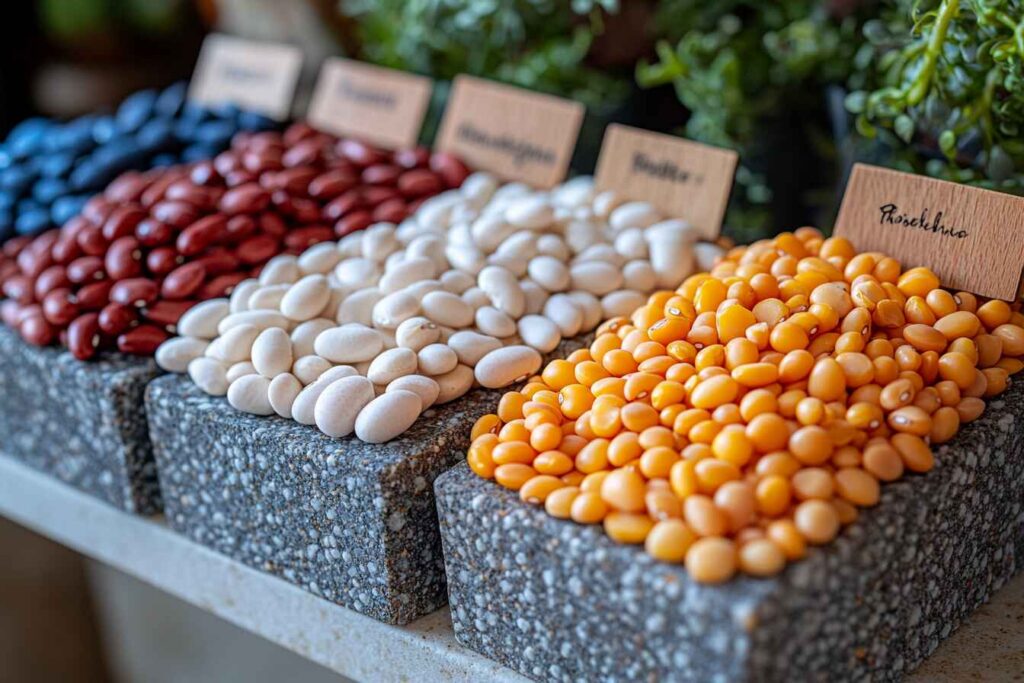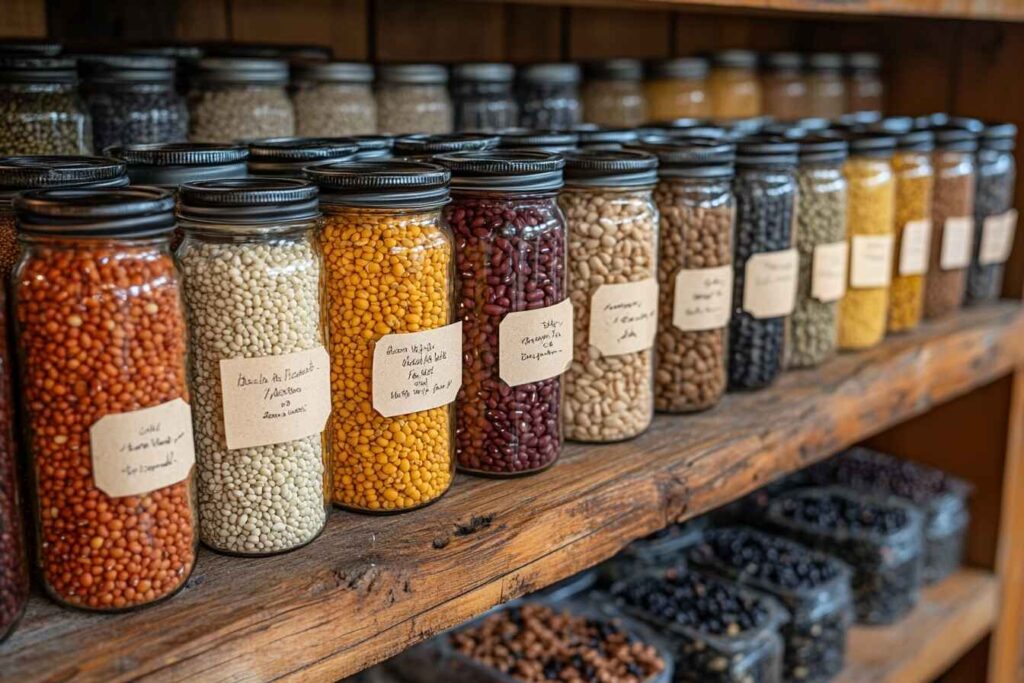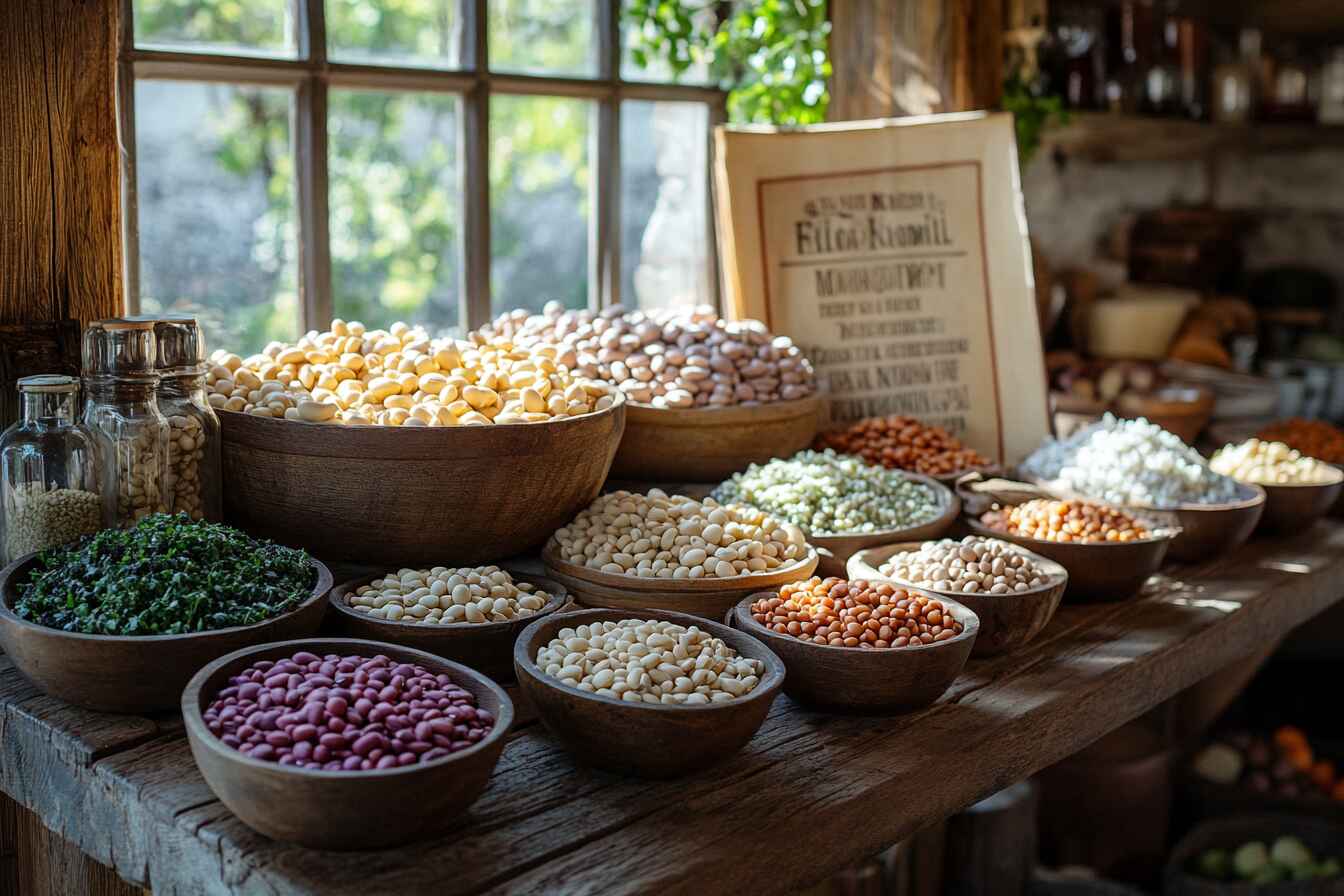Ever wondered what fagioli beans are? If you’re a fan of Italian cuisine, you’ve probably come across them in classic dishes like Pasta e Fagioli or a hearty bean soup. But what exactly are these beans, and why are they so popular?
Fagioli beans, simply put, refer to a variety of beans commonly used in Italian cooking. The word “fagioli” (pronounced fah-JOH-lee) is Italian for “beans,” and it encompasses different types, from creamy Cannellini to speckled Borlotti. These beans are not only delicious but also packed with nutrients, making them a staple in Mediterranean diets.
Did you know? The word “fagioli” comes from the Latin word “phaseolus,” meaning small bean.
Whether you’re a seasoned cook or just getting started in the kitchen, this guide will walk you through everything you need to know about fagioli beans—types, benefits, how to cook them, and more!
Understanding Fagioli: Meaning and Origin
Fagioli beans have deep roots in Italian history. These legumes have been a dietary staple for centuries, providing an affordable, protein-rich food source for families across Italy. You’ll find them in everything from soups and stews to salads and side dishes.
The Historical Significance of Fagioli Beans
Legumes have been cultivated for thousands of years, but in Italy, they became particularly popular during the Roman Empire. The Romans relied on beans as a crucial protein source, especially for soldiers and laborers.
Fun Fact: Ancient Romans used fagioli beans as an alternative to meat, making them one of the first known “plant-based proteins” in history!
As time passed, different regions in Italy developed their own unique ways of using fagioli beans. In Tuscany, they’re the star of Fagioli all’Uccelletto (beans in tomato sauce), while in Naples, they’re often paired with pasta for a comforting meal.
Different Types of Fagioli Beans
Not all fagioli beans are the same! Depending on the recipe, different varieties bring unique textures and flavors to the table. Here are the most popular types of fagioli beans:
Cannellini Beans: The Classic White Fagioli
Cannellini beans are the most well-known type of fagioli. They are large, oval-shaped, and creamy in texture. Their mild flavor makes them a perfect addition to soups, salads, and stews.
Best Uses: Pasta e Fagioli, White Bean Soup, Tuscan Bean Salad

Borlotti Beans: The Speckled Italian Delight
Borlotti beans, also known as Cranberry beans, are easily recognizable by their beige color with red streaks. They have a slightly nutty taste and turn a deep brown when cooked.
Best Uses: Italian Minestrone, Bean Stews, Side Dishes
Navy Beans vs. Fagioli: Are They the Same?
Many people assume that navy beans and Italian fagioli are the same, but they have slight differences. Navy beans are smaller, rounder, and softer, while varieties like cannellini are larger, oval-shaped, and slightly firmer in texture.
That said, these mild-flavored legumes can often be used interchangeably in soups, stews, and side dishes. If a recipe calls for fagioli and you only have navy beans, go ahead and swap them—the result will still be delicious!
Lupini Beans: A Lesser-Known Fagioli Variety
If you’ve never tried lupini beans, you’re missing out! These beans are often eaten as a snack in Italy. They require a long soaking process due to their natural bitterness, but once prepared, they’re deliciously crunchy and slightly salty.
Nutritional Benefits of Fagioli Beans
Fagioli beans are more than just tasty—they’re a nutritional powerhouse! These beans are loaded with fiber, protein, and essential vitamins, making them an excellent choice for a balanced diet.
Protein-Packed Goodness: Why Fagioli Are Great for Vegans
Looking for a plant-based protein source? Fagioli beans have got you covered! They are rich in protein, making them a great alternative to meat.
| Nutrient | Amount per 1 cup (cooked) |
|---|---|
| Protein | 15g |
| Fiber | 13g |
| Iron | 4mg |
| Calories | 225 |
Fiber-Rich and Gut-Healthy: Digestive Benefits of Fagioli Beans
One of the best things about fagioli beans is their high fiber content. This means they help with digestion and keep your gut healthy. Plus, they keep you full longer—perfect for weight management!
Vitamins and Minerals: What Makes Them Nutritious?
Fagioli beans are packed with important vitamins and minerals, including:
- Iron: Boosts energy and supports healthy blood circulation.
- Magnesium: Helps with muscle function and relaxation.
- Folate: Essential for cell growth and development, especially important during pregnancy.
How to Cook Fagioli Beans: A Step-by-Step Guide
Cooking fagioli beans isn’t complicated, but there are a few things you should know to get the best results.
Soaking vs. No-Soak Method: Which Works Best?
Soaking beans overnight helps reduce cooking time and improves digestion. However, if you’re short on time, the no-soak method works too—it just takes a bit longer.
Tip: To quick-soak beans, boil them for 2 minutes, remove from heat, and let them sit for an hour before cooking.
Stovetop Cooking vs. Pressure Cooker: Time-Saving Tips
There are two main ways to cook fagioli beans:
- Stovetop Method: Simmer the beans in water for about 1-2 hours until tender.
- Pressure Cooker (Instant Pot): Cuts cooking time to just 30-40 minutes with no soaking needed.
Common Mistakes When Cooking Fagioli Beans and How to Avoid Them
Here are a few mistakes people make when cooking beans—and how to fix them:
- Adding salt too early: This can make the beans tough. Add salt towards the end of cooking.
- Not soaking enough: If your beans take forever to cook, it’s likely because they weren’t soaked long enough.
- Using old beans: Beans that have been stored for too long may never soften properly.
Pro Tip: Always check the expiration date on dried beans before cooking!
Popular Fagioli Bean Recipes
Now that you know about fagioli beans and how to cook them, let’s talk about the fun part—delicious recipes!
Whether you’re craving a cozy soup, a hearty stew, or a light salad, these nutritious legumes are incredibly versatile. From rustic Italian classics to modern creations, here are some of the best ways to enjoy them.
Pasta e Fagioli: The Classic Italian Comfort Dish
One of the most beloved Italian recipes, Pasta e Fagioli is a flavorful, budget-friendly soup. A staple in Italian homes, it combines tender legumes, pasta, and a rich tomato broth for the perfect balance of protein and carbs.
Ingredients:
| Ingredient | Quantity |
|---|---|
| Cannellini beans (cooked) | 1 ½ cups |
| Pasta (ditalini or small shells) | 1 cup |
| Olive oil | 2 tbsp |
| Garlic (minced) | 3 cloves |
| Onion (chopped) | 1 small |
| Tomato sauce | 1 cup |
| Vegetable broth | 4 cups |
| Salt & pepper | To taste |
| Parmesan cheese (optional) | To garnish |
Instructions:
- Heat olive oil in a pot over medium heat. Sauté garlic and onions until fragrant.
- Add tomato sauce and vegetable broth. Bring to a simmer.
- Stir in cooked beans and let the flavors blend for 10 minutes.
- Add pasta and cook until tender.
- Season with salt and pepper. Serve warm with grated Parmesan.
Tip: Want a thicker soup? Blend a small portion of the beans before adding them to the pot!
Fagioli All’Uccelletto: A Tuscan Bean Delight
This is a simple yet flavorful dish of fagioli beans simmered in a rich tomato sauce with garlic and sage.
Ingredients:
- 2 cups cooked cannellini beans
- 1 cup tomato puree
- 2 tbsp olive oil
- 2 cloves garlic, minced
- 2-3 sage leaves
- Salt & pepper to taste
Instructions:
- Heat olive oil in a pan and sauté garlic until golden.
- Add tomato puree and sage leaves, cooking for 5 minutes.
- Stir in the beans and let simmer for 15 minutes.
- Season with salt and pepper, then serve warm.
Serving Suggestion: Pair this dish with crusty bread for a rustic Italian meal!
Common Problems When Cooking Fagioli Beans
Cooking beans sounds easy, but sometimes things don’t go as planned! Here are some common issues and how to fix them.
Why Do Fagioli Beans Stay Hard After Cooking?
Ever cooked beans for hours, only to find them still rock hard? There are a few reasons this happens:
- Old beans: Dried beans older than a year may never soften properly.
- Not soaking long enough: Beans need time to absorb water before cooking.
- Hard water: High mineral content in water can prevent beans from softening.
Solution: Use fresh beans, soak them overnight, and cook with filtered water.
How to Reduce Gas and Bloating from Beans
Beans are packed with fiber, but they can also cause bloating. To reduce this:
- Soak overnight: This removes some of the gas-producing sugars.
- Rinse canned beans well: The liquid contains indigestible sugars.
- Add a bay leaf: It helps break down compounds that cause gas.
Did you know? Chewing beans thoroughly helps with digestion!
Fixing Overcooked or Mushy Beans
If your beans turn to mush, don’t panic! You can still use them:
- Make a bean puree for soups or dips.
- Blend them into a creamy pasta sauce.
- Use them in veggie burgers or bean patties.
Storing and Preserving Fagioli Beans
How to Store Dried Fagioli Beans Properly
To keep dried beans fresh, store them in an airtight container in a cool, dry place. Avoid humid areas, as moisture can cause mold.
Pro Tip: Label your beans with the purchase date so you know how fresh they are!
Freezing Cooked Beans: A Practical Storage Solution
If you have leftover cooked beans, freezing them is a great way to prevent waste.
How to Freeze Beans:
- Let the beans cool completely.
- Spread them on a baking sheet in a single layer and freeze for an hour.
- Transfer to freezer bags, removing excess air.
- Label the bags with the date and store for up to 6 months.
Shelf Life and Signs of Spoiled Beans
Dried beans: Last up to 2 years if stored properly.
Cooked beans: Stay fresh in the fridge for 4-5 days.
Signs of spoilage:
- Bad smell
- Slime or mold
- Unusual discoloration
Warning: If beans smell sour, toss them! Eating spoiled beans can cause food poisoning.

Substitutes for Fagioli Beans in Recipes
Can’t find fagioli beans at your local store? No worries! There are plenty of alternatives that work just as well in recipes. Whether you’re out of cannellini beans or borlotti beans, here are some great swaps.
What to Use When You Can’t Find Fagioli Beans
| Fagioli Bean Type | Best Substitutes |
|---|---|
| Cannellini Beans | Great Northern Beans, Navy Beans |
| Borlotti Beans | Pinto Beans, Kidney Beans |
| Navy Beans | White Beans, Great Northern Beans |
| Lupini Beans | Chickpeas, Fava Beans |
Tip: If you’re replacing beans in a soup or stew, choose a substitute with a similar texture and flavor.
Taste and Texture Comparisons with Other Beans
- Cannellini vs. Great Northern: Both are mild, but Great Northern beans are slightly firmer.
- Borlotti vs. Pinto: Both are creamy and nutty, but pinto beans are softer.
- Lupini vs. Chickpeas: Lupini beans are firmer and crunchier, while chickpeas are softer.
Health Benefits and Risks of Eating Fagioli Beans
Fagioli beans are more than just a tasty ingredient—they’re a **nutritional powerhouse** with incredible health benefits.
Benefits of Including Fagioli in Your Diet
- Heart Health: The high fiber content helps lower cholesterol and reduce the risk of heart disease.
- Blood Sugar Control: Low on the glycemic index, they help maintain stable blood sugar levels.
- Weight Management: The combination of protein and fiber keeps you full longer, preventing overeating.
- Gut Health: Their prebiotic fiber supports healthy gut bacteria.
Who Should Avoid Eating Too Many Beans?
While fagioli beans are super healthy, some people should eat them in moderation:
- People with digestive issues: Beans contain oligosaccharides, which can cause bloating and gas.
- Individuals with gout: Beans are high in purines, which may trigger gout flare-ups.
- Those with kidney issues: The potassium content in beans can be problematic for people with kidney disease.
Managing Digestive Issues When Eating Beans
Worried about bloating or gas from beans? Here are a few tips to reduce discomfort:
- Soak beans overnight: This removes some of the gas-producing sugars.
- Cook beans thoroughly: Undercooked beans are harder to digest.
- Add digestive aids: Cooking beans with bay leaves, cumin, or fennel can help reduce gas.
Did you know? The more often you eat beans, the better your body gets at digesting them!
Where to Buy Fagioli Beans
Now that you’re ready to cook with fagioli beans, where can you find them?
Supermarkets vs. Specialty Stores: Where to Find the Best Beans
- Supermarkets: Most grocery stores carry canned and dried fagioli beans, especially **cannellini** and **navy beans**.
- Italian Markets: If you’re looking for **borlotti** or **lupini beans**, check Italian specialty stores.
- Health Food Stores: These often stock organic, non-GMO beans.
Online Shopping Tips for Buying Quality Beans
Buying beans online is a great option if you’re looking for rare varieties.
What to Look For:
- Check reviews to ensure quality.
- Buy from reputable sellers (Amazon, Italian food markets, organic shops).
- Look for beans with a **recent harvest date** for the best texture and flavor.
Tip: Always store dried beans in airtight containers after buying to preserve freshness!
Conclusion:
So, now you know all about **fagioli beans**—what they are, how to cook them, their health benefits, and even where to buy them. These little legumes are a must-have in any kitchen, offering a **rich, creamy texture** and a **nutrient-packed punch**.
Whether you enjoy them in a classic Pasta e Fagioli, a hearty soup, or a fresh salad, fagioli beans are incredibly versatile. Plus, they’re affordable, easy to cook, and an **excellent plant-based protein** source.
Ready to give them a try? Start experimenting with different recipes and enjoy the **delicious, wholesome goodness** of fagioli beans today!
Final Thought: If you haven’t cooked with fagioli beans yet, now is the perfect time to start. Once you do, you’ll wonder how you ever lived without them!

